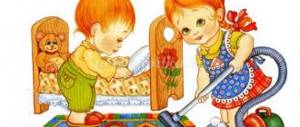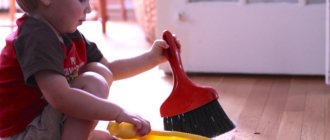Peculiarities of work activity of preschool children
It is important for adults not to miss the moment when children want to work and participate in household chores. This desire awakens in preschool age. With competent support, adults will be able to strengthen interest in work, while removing the child from work will gradually discourage him from wanting to work physically.
Why do mothers, fathers, and grandmothers often prefer to prohibit a child’s participation in any activity rather than support it? The reason is either increased anxiety for the child - lest he hurt himself, lest he harm himself while trying to manipulate the mop, reach the faucet, etc. Or adults are dissatisfied with the child’s inept actions, after which there will be even more washing and cleaning.
But you will have to come to terms with these moments if adults understand their own responsibility for instilling hard work in their little helper.
A characteristic feature of the work activity of a preschooler is that the child is focused not on a quality result, but on the immediate process. At preschool age, the need to take part in real life and be involved in the world of adults becomes actualized. This need can be realized by getting involved in specific activities.
This need is only partially realized in gaming activities. Children often simulate adult life in story-based games. But they understand that this is “make-believe.” And young people want real participation in real things that they observe every day at home or in kindergarten.
In labor, the child gets the opportunity to independently perform those actions that he previously only observed. By making efforts, the child believes that he, like an adult, is useful. That is why work activity is so attractive in preschool age.
Motives that encourage children to work
The motivation to put in work effort changes as the preschooler grows up. Motive is a structural component of any activity. Along with operations, it shapes the labor process from an early age. Other components of the work activity of preschoolers appear later.
Three- to four-year-old children are motivated by interest in the process itself. It’s so interesting to stir a ladle in a pan or move it with a vacuum cleaner brush.
In middle preschool age, children are pushed to do feasible work by incentives and reprimands . For example, a child is happy to wipe cutlery because his mother praises what a wonderful helper he is. In the same way, a preschooler quickly puts his toys in order, because after cleaning, dad promised to read a book together. Or the child independently begins to put together the scattered parts of the construction set so that his mother does not scold him.
The highest level in preschool age is social motives for work . Guided by these motives, children move from performing exciting actions or things for which they expect praise to actions that are important to other people.
Making a craft as a gift for mom, helping grandma water the garden, putting on shoes and tying shoelaces for a younger sister are examples of things that older preschoolers do in an effort to show concern for loved ones. In such cases, the question of whether the immediate process is interesting is not considered. The child realizes the value of his labor participation for the benefit of others.
Labor education in a playful way
Play is the best means of child development. In the game, he can be taught not only to run or jump, but also to think, make decisions, develop speech, draw conclusions, behave in society, build communications - and, of course, work.
In kindergarten, various games are played with preschoolers: both theoretical and practical.
The first ones are aimed at expanding preschoolers’ understanding of different professions, the skills required for each of them, as well as the ability to correlate people’s actions with their professions, means and tools. These include, for example, the following:
- Who works where?
- Who does this?
- Who can do this?
- Who's doing what?
- Who needs what for work?
- What comes first and what comes next?
- Guess what I'm doing? And etc.
The second category allows you to master various practical skills in a playful way. In such games, children learn to work, imitating adults:
- drive and repair cars;
- set the table for the dolls;
- “cook” in children’s dishes;
- learn to use toy appliances (irons, ovens, washing machines, vacuum cleaners).
You can successfully use all these types of games at home. In addition, the following home “work” games are excellent training:
- who is faster (wipe the dust, collect the toys);
- who can do it better (clean the room, fold things);
- “Funny stories” - in the process of everyday homework, parents compose and tell their children interesting stories from the “life” of cups and saucepans, nails and hammers;
- “Inspectors”: they explain to the child that today the quality of his cleaning in the play area will be checked by his favorite bear (doll, bunny) - the diligence of the kids increases sharply;
- “Toy life” - parents and children wash toy dishes, wash doll clothes, fix broken toys, etc.;
- “Talent competition” is a competition between children (you can invite neighbors or friends) in drawing, making all kinds of crafts, and applications. This trains manual skills and develops fine motor skills.
Organization of work activities of preschool children
Work activities throughout preschool childhood become more complex, covering the path from mastering self-service skills to performing household duties and caring for plants and pets.
At 3-4 years old, even brushing your teeth or getting dressed for a walk on your own is difficult. With the development of a child’s manual skill, self-service skills are automated and move from the category of “work” into everyday actions. The work activity of a preschooler is filled with other processes involving the development of tools and the achievement of results.
The uniqueness of the work activities of younger preschoolers
It is clear that a 3-year-old child will persistently demand to be allowed to test in the kitchen in order to “help” make pies. But his interest will dry up in response to an offer to tidy up the gaming corner of his room.
The main reason is the lack of novelty, and therefore the lack of excitement in the process. Other, no less important reasons are added to it. The kid may simply not understand how to restore this very order...
In early preschool age, in order to introduce a child to work that is feasible for him, it is important to give specific and understandable instructions. “Put the cubes in a box, put the box on the shelf”, “Put your socks in a drawer” - after hearing such instructions, the baby will understand what they want from him at the moment, and will also gradually form a sequence for putting things in order.
Clear instructions are an essential element in developing a preschooler’s work skills.
Only by mastering the rules that allow him to organize his work will a preschooler be able to independently initiate and complete everyday work activities in the future.
Labor in older preschool age
Older preschoolers are introduced to work not for the sake of participation. Although there are also cases when 6-7 year old children are driven solely by curiosity: “How do you spin that? Let me try.” “I also want to dig” - the child takes up a shovel, but after a few attempts he loses the desire to do something that is quite physically difficult.
However, in most cases, all components of work activity can be traced in the activities of preschoolers: motive, goal, actual actions, control and evaluation . That is, the child sees the goal for applying his efforts, chooses the means, how he can get the result, performs the actions and is interested in the result of his work.
For example, 5-year-old Masha reports that she wants to sweep the room “to make it clean.” Having at least practiced with a broom, she collects the garbage in a dustpan and immediately asks if she swept well. Although the girl relies solely on praise for her efforts, she is interested in achieving her goal.
Mastering the components of work activity contributes to the development of the personal qualities of a preschooler. There is a direct influence on the formation of the following qualities:
- hard work
- responsibility
- independence
- perseverance
- criticality
Older preschoolers evaluate their work more objectively. They notice, unlike younger children, gross shortcomings and try to correct them. But it is important to them how an adult evaluates the quality of their work actions, so they ask appropriate questions.
Thanks to the development of speech, children in older preschool age are well able to perceive verbal instructions on how to perform a certain task. Adults will help the child if together they discuss the sequence of steps that will lead to the desired result.
Features of the work of a preschooler: how, why and why?
In preschool education, one of the main things is the organization and training in work activity and teaching many of its methods available to children in groups of this age. There has long been an expression among people that labor turned an ordinary animal (monkey) into a highly developed intelligent being (human). And, no matter how exaggerated these words sound, there is some truth in them.
In the process of organizing labor activity, organized and expedient, the child receives the necessary knowledge and skills, but this is not even the main benefit. Through the necessary actions performed by the body, the brain also develops, or rather, even the basic mental functions: thinking, perception, will. That is why labor education of preschool children is a very important and serious area.
Socialization of a preschool child in work activity
Work is an effective condition for the socialization of a child. A preschooler watches how other children perform certain labor activities, and he also wants to join such an activity. When doing a task, communication invariably begins. Children love to share advice in the style: “You’re doing it wrong! Look at me!
You can observe how preschoolers exchange tools, testing the better (or worse) the tool of their lesson partner. Carrying out a common task, they learn to negotiate, distribute responsibilities, come up with rules, and control their implementation.
Even in collective work, excellent opportunities are found for developing the skills to control and evaluate one’s own work and the activities of others. The child observes how an adult evaluates the work of other children and perceives evaluative statements as a guide for his actions.
The labor involvement of a preschooler is far from the main one among the activities that children engage in before school. But work plays a crucial role in raising a child, in the emergence of the need to work. Without the timely development of work skills and awareness of the social motives of work, a growing child is unlikely to become a hardworking and responsible person in the future.
How to develop hard work in children
For a child to become hardworking, he must be raised. But most importantly, he should experience joy from work.
In a playful way, children gain skills and abilities to work
Child labor is unique:
- in terms of content, the work is simple;
- actions are available;
- connection with game processes.
If you watch children, you can see that for 2-3 years the work of an adult is reflected in the game. Children imitate the actions of their elders. Let your child watch adults doing some work. Kids can wash clothes for dolls, wash soft toys, and finally tidy up their room or children's corner. Children aged 5-6 years, as well as seven-year-olds, already play situational games. Such means are excellent in developing labor skills.
Situational games are an exciting method of labor education
The content of a child’s work is similar to the content of an adult’s work. It is important that work is meaningful, brings joy and ignites creative impulses.
Various types of work for preschoolers
Since the work activity of children in preschool age should have a clear content, clear organization and interest for each child, it should also have a variety of types. This is how it really is.
First of all, it all starts with self-care. This is a very important type of work activity, because it teaches the child to do without the help of an adult, to keep himself clean and comfortable, to be able to dress, perform hygiene procedures, and to be minimally dependent on elders in basic everyday matters. At first it needs organization, but then it becomes automatic.
- Household work is an activity that teaches order, both indoors and outdoors. In the process, the child learns to use various household items and devices, gains a complete understanding of them and learns to make some himself. It has clear content and is required in all groups.
- Labor in nature is aimed at putting the site and surrounding street and forest areas in order. It also has a healing character, teaching you to be careful about everything around you. Needs careful organization and thinking through each stage on the part of adults to make it safe and productive.
- Manual (or artistic) labor is the creation of works of art of one kind or another. It evokes a huge emotional response, makes children happy, and allows them to express themselves. An important stage in the formation of a confident and creative personality.
Thus, labor education of preschool children is the most important aspect in their harmonious development and formation of an integral personality. On the part of adults, a clear organization and explanation to the child of the meaning of his work is required, but the baby will learn the rest on his own. After all, as you know, theory means nothing without practice.
At what age does work begin?
So, since this article is focused exclusively on the preschool age, it is important to define it right away. The final stage is quite obvious: this is the period from 6.5 to 7 years, when the child goes to school. Conventionally, in psychology, the upper limit is considered to be 7 years, but for some the transition to school time (junior schoolchildren) occurs a little earlier, for others a little later. It all depends on a purely formal moment: entering first grade and starting school.
It is much more difficult to determine the lower limit. When can a child’s activity be called work, and can we begin to teach him to perform conscious actions without fear that he will harm himself? In psychology, it is believed that this age begins at 3 years old. Here, too, it should be understood that this is only formal: it is different for different children.
Some are already ready at 2.5, while others are just starting to succeed at 3.5. And yet, at about 3 years old, the child moves from object-manipulative activities (when he touched and felt objects, not always understanding their real purpose) to role-playing games. He develops a social interest and begins to learn how to build relationships and connections. Then it is advisable to begin full-fledged labor education, and the forms can be completely different.






